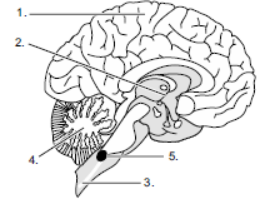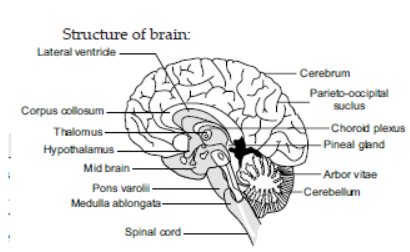Table of Contents


Ans.(a) 1-Cerebrum, 2-Hypothalamus, 3-Spinal cord, 4-Cerebellum, 5-Medulla
Explanation:

Ans. (b) Gray matter is major
Explanation:
Gray Matter is the tissue which forms the major component of the central nervous system(CNS). It is found at the exterior part of the brain. It is also present in the spinal cord. It is majorly composed of Nerve cell body.
Explanation:
Photoreceptors found in the retina of the eye are rods and cons.
Explanation:
The Central Nervous system comprises both the spinal cord and brain. The central nervous system includes the brain and spinal cord which are responsible for processing the information received from various body parts. The brain contains centres for processing sensory information and the spinal cord emerges from the lower part of the brain and produces reflex actions.
Explanation:
Structure of taste buds : Structure of taste buds : There are four primary tastes–sweet, salty, sour and bitter. The taste receptors are called taste buds. Each taste bud opens on the tongue surface through a taste pore. Each taste bud contains 60–65 spindle-shaped cells, out of which 5-15 are taste receptor cells and others are supporting cells. The taste receptor cells produce protoplasmic outgrowths called taste hair. The taste hair projects through taste pores and receives the stimulus of taste.
| Taste buds | Location |
|---|---|
| Sweet | Front of the tongue |
| Salt | Tip and sides of the tongue |
| Bitter | Rear side of the tongue |
| Sour | Back and sides of the tongue |
Download Mind Map of this chapter
Download NowWant to Practice Mock Tests of this chapter
Practice NowDownload Important Questions of this chapter
Download Now| Chapter No. | Chapter Name |
|---|---|
| Chapter 1 | Structure of Chromosome, Cell Cycle and Cell division |
| Chapter 2 | Genetics: Mendel's law of Inheritance |
| Chapter 3 | Absorption by Roots- The Processes Involved |
| Chapter 4 | Transpiration |
| Chapter 5 | Photosynthesis |
| Chapter 6 | Chemical Coordination in Plants |
| Chapter 7 | The Circulatory System |
| Chapter 8 | The Excretory System |
| Chapter 9 | The Nervous System and Sense Organs |
| Chapter 10 | The Endocrine System |
| Chapter 11 | The Reproductive System |
| Chapter 12 | Human Population |
| Chapter 13 | Human Evolution |
| Chapter 14 | Pollution |
CBSE Important Questions Class 10
ICSE Important Questions Class 10
CBSE Important Questions Class 10
ICSE Important Questions Class 10